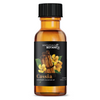
Understanding Cassia Essential Oil Benefits
With its warm, spicy scent and bold presence, Cassia Essential Oil is often described as cinnamon’s fiery cousin. Steam-distilled from the bark of the Cinnamomum cassia tree, this essential oil brings a rich, sweet-spicy aroma that’s as energizing as it is comforting.
While it shares many characteristics with cinnamon bark oil, cassia essential oil stands out for its intensity and versatility—especially in home fragrances, seasonal blends, and DIY body products. In this guide, we’ll explore the many ways to use cassia essential oil safely and effectively, and what makes it such a powerful addition to your aromatherapy toolkit.
What Is Cassia Essential Oil?
Cassia essential oil is derived from the bark of the cassia tree, a close relative of the cinnamon tree. Native to China and Southeast Asia, Cinnamomum cassia has been used for centuries for its aromatic and preservative qualities.
The oil itself is a deep amber color with a sweet, spicy aroma that’s unmistakably bold. It’s often compared to cinnamon, but cassia tends to be slightly sweeter and more pungent.
Because of its strength and the presence of cinnamaldehyde (its main aromatic compound), cassia oil is highly potent—both in scent and in topical use. That makes dilution and careful blending essential when working with this oil.
Cassia Essential Oil Benefits in Everyday Use
Cassia essential oil is ideal for adding warmth and spice to your wellness routines, home rituals, and handcrafted products.
Use Cassia Essential Oil As a Bold Addition to Diffuser Blends
If you're crafting diffuser blends that evoke coziness, cassia essential oil brings depth and richness. It’s especially popular in fall and winter blends, but can also be used year-round for its inviting and uplifting scent.
Try Blending:
-
2 drops cassia
-
3 drops sweet orange
-
2 drops cedarwood
This creates a warm, grounding aroma that makes any space feel more welcoming.
Due to its strength, cassia can easily overpower more delicate oils, so it’s best used sparingly in diffuser recipes.
Incorporate Cassia Into Your Home Fragrance Products
Cassia’s bold scent makes it a favorite in candles, potpourri, and homemade room sprays. Its warm aroma adds a festive, cozy vibe to any space, and pairs beautifully with clove, vanilla, fir, and citrus oils.
In sprays, combine with distilled water and a touch of grain alcohol to disperse the scent evenly. Always test on fabrics first if using as a linen spray.
Adding Cassia Essential Oil into Topical Blends
Cassia essential oil can be used in body care products and massage oils, but with extra caution. It’s a “hot” oil, which means it may cause a warming or tingling sensation—and if used undiluted, can lead to skin irritation.
Safe topical use tips:
-
Always dilute cassia essential oil before applying to the skin.
-
Use a very low dilution: 0.05%–0.5% (roughly 1 drop per 2–4 tablespoons of carrier oil).
-
Avoid using on sensitive skin, mucous membranes, or broken skin.
-
Perform a patch test before using any cassia-infused product more broadly.
For a warming winter body oil, try combining cassia (at a low dilution) with jojoba oil, vanilla oleoresin, and a touch of ginger or black pepper.
Enhancing DIY Cleaning and Air Freshening Sprays
Cassia’s scent naturally complements citrus and herbal oils often used in cleaning sprays. While it doesn’t have to serve a functional purpose beyond fragrance, many people enjoy its ability to freshen a room with just a few spritzes.
Try this cozy cleaning blend:
-
1 cup distilled water
-
½ cup white vinegar
-
5 drops cassia essential oil
-
10 drops lemon essential oil
-
5 drops rosemary or eucalyptus essential oil
Shake well before each use and store in a glass spray bottle for a stylish touch.
How to Use Cassia Essential Oil Safely
Cassia essential oil is highly concentrated and naturally potent, so proper handling is key to enjoying its benefits without irritation or overwhelming scent.
Dilution Guidelines
Because cassia is a dermal irritant in higher concentrations, it should always be heavily diluted in a carrier oil like fractionated coconut, jojoba, or sweet almond oil before being applied to skin. Stick to very low dilution rates and avoid use on the face or sensitive areas.
Perform a Patch Test
Before using any new essential oil topically, especially a strong oil like cassia, do a patch test. Apply a small amount of diluted oil to the inside of your forearm and wait 24 hours to check for any adverse reaction.
Diffuse with Care
Cassia oil’s scent is bold—sometimes just one drop is enough in a blend. Use in moderation, and diffuse in a well-ventilated area for short periods. Its warming, spicy scent can be a beautiful highlight when balanced with softer oils.
General Precautions When Using Cassia Essential Oil
To use cassia essential oil safely, always follow these tips:
-
Keep cassia essential oil out of reach of children and pets.
-
Do not apply near eyes, ears, or other sensitive areas.
-
Store in a cool, dark place to preserve its shelf life and potency.
-
If you're pregnant, nursing, or have a health condition, it’s a good idea to check with your doctor before using any new essential oil.
Choosing the Right Cassia Essential Oil
The best cassia essential oil is pure, unblended, and sourced with care. At Wholesale Botanics, their Cassia essential oil is steam-distilled from the bark of Cinnamomum cassia, offering a clean and powerful aromatic profile that is perfect for diffusers, body products, and custom fragrance blends.
Take Advantage of Cassia Essential Oil Benefits

Cassia essential oil brings a bold, spicy-sweet scent to the table—perfect for warming up a space, adding flair to a DIY project, or crafting rich, seasonal aromatherapy blends. With a little care and creativity, it can elevate your routines with depth and character.
Whether you’re creating a signature fall fragrance or simply looking to experiment with new diffuser blends, cassia adds warmth, complexity, and a hint of nostalgia to your collection.
